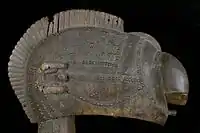Simo (society)
The Simo society is a secret society in West Africa (esp. Ghana, Mali, Sierra Leone) also described as a "masked cult".[1] It hails, according to a UNESCO report, from among either the Temne people or the Baga people at the time of the Mali Empire.[2] The Susu people's political organization "assigned an important role to the Simo initiation society", and it "dominated" the organization of the Baga and the Landuma people.[3]

Initiation and other rites included masks, and of particular importance were fertility rites.[4] The Simo were also one of many secret "cultic groups" (whose priests "possessed immense knowledge of herbs and roots") that practiced medicine to cure specific ailments.[5]
Observations by early white ethnographers
French explorer René Caillié, the first European to travel to Timbuktu and return alive, described a group of young men living in the forest along the Nunez River after being initiated (through circumcision) by a man called the Simo, who is never seen by anyone except for his young companions who stay with him for seven or eight years. The Simo also acts as a chief magistrate to the locals; his place of residence in the forest is to be left in peace at all time and infractions have to be atoned for with gifts handed over in a ritual manner—with the giver keeping his back to the Simo.[6]
According to a 1908 study by Hutton Webster, the Simo had degenerated from a "powerful organization devoted to the interests of the people" into little more than a group that organized dances and dressed up.[7]
Masks
Masks, decorated with "animal, reptile and human attributes" are used in ritual.[8]
References
- Isichei, Elizabeth Allo (1997). A History of African Societies to 1870. Cambridge UP. p. 223. ISBN 9780521455992. Retrieved 27 July 2012.
- Ki-Zerbo, Joseph (1998). UNESCO General History of Africa, Vol. IV, Abridged Edition: Africa from the Twelfth to the Sixteenth Century. U of California P. p. 124. ISBN 9780520066991. Retrieved 27 July 2012.
- General History of Africa: Africa from the Twelfth to the Sixteenth century. UNESCO. 1981. pp. 307, 315. ISBN 9789231017100. Retrieved 27 July 2012.
- Segy, Ladislas (1976). Masks of Black Africa. Courier Dover. p. 60. ISBN 9780486231815. Retrieved 27 July 2012.
- Laet, Sigfried J. de (1994). History of Humanity: From the seventh to the sixteenth century. UNESCO. p. 505. ISBN 9789231028137. Retrieved 28 July 2012.
- Caillié, René (1830). Travels through Central Africa to Timbuctoo: and across the great desert, to Morocco, performed in the years 1824-1828. H. Colburn and R. Bentley. pp. 153–58. Retrieved 28 July 2012.
- Webster, Hutton (1908). Primitive secret societies: a study in early politics and religion. Macmillan. p. 172. Retrieved 28 July 2012.
- Sieber, Roy; Arnold Rubin (1969). "On the Study of African Sculpture". Art Journal. 29 (1): 24–31. JSTOR 775272.